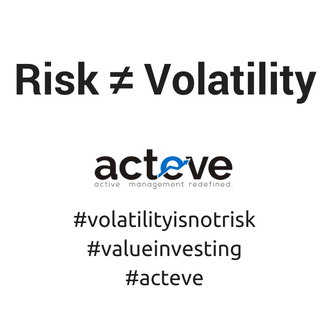You and I use the word “risk” frequently in our lives, without really thinking about its definition or knowing whether others around us think of it the same way as us. Not having a specific definition of risk might be acceptable in a non-financial setting; but when it comes to investing, it is critical to have a clear definition of risk. Turns out that your definition of risk will determine how you select investments.

Academicians and financial marketeers (e.g. mutual funds, index funds, robo advisors, stock brokers) have directly or indirectly popularized a definition of risk that may be mathematically elegant, but does not do justice to the attributes that we intrinsically assign to our concept of risk. As human beings we are most concerned about the likelihood of a (permanent) loss (of assets) over a given time period. We aren’t necessarily worried about the temporary/transient variability of price trajectory over shorter intermediate periods. Yet this transient variability is what the financial services industry insists on calling risk, perhaps only because it can be measured easily. Furthermore, such a quantitative definition of risk also breeds obsessive focus on short-term price movements, an activity that generates lucrative commissions for the financial services industry.
Real risk is usually invisible, and most often assessed only qualitatively at best. Yet in the investment world marketeers will try to sell you a precise definition of risk, with a litany of products designed to manage that risk. And you are too busy working, to be able to call their bluff. They will convince you that filling out rudimentary questionnaires about your risk appetite is sufficient for their machines to precisely estimate your risk tolerance, and automatically assign portfolio allocations for you. This is why there are thousands of financial advisors – they have mastered the great skills of dialing the telephone, and administering a risk assessment questionnaire to individuals that have at best an incomplete idea of what it all means.
From a practical standpoint, investment risk is the chance that your investment thesis is incorrect, fundamentals are actually different from what you believed to be the case, and a faulty (or absent) margin of safety assessment might translate into loss of principal. Extending the investment time horizon substantially might solve some of the problems, but the majority of problems will persist, making recovery of principal difficult. With such a real definition of risk, you have to work hard to uncover what you don’t know, and then get comfortable with such lack of knowledge prior to making an investment.
This brings us to the idea (a central idea in value investing) that investment risk is a function of the fundamentals surrounding an investment, not the volatility of how it trades. To assess fundamentals you need equity research. The problem is that the financial services industry hasn’t yet figured out how to monetize research effectively – until it does, be prepared to ask the next financial advisor calling you for her definition of risk!
Also see: What is Risk? A Value Investor’s Perspective
Author: Sundeep Bajikar
Disclosures and Disclaimer

